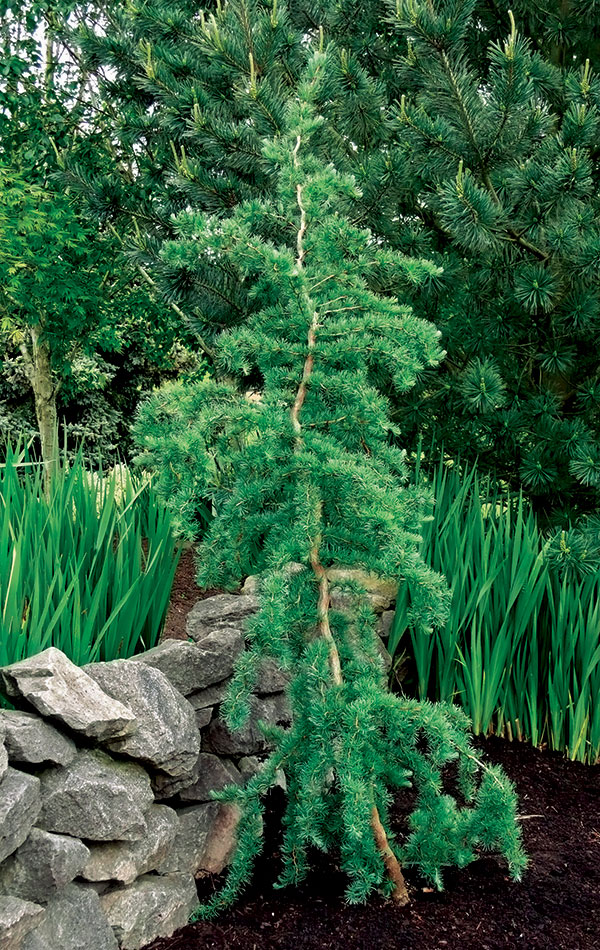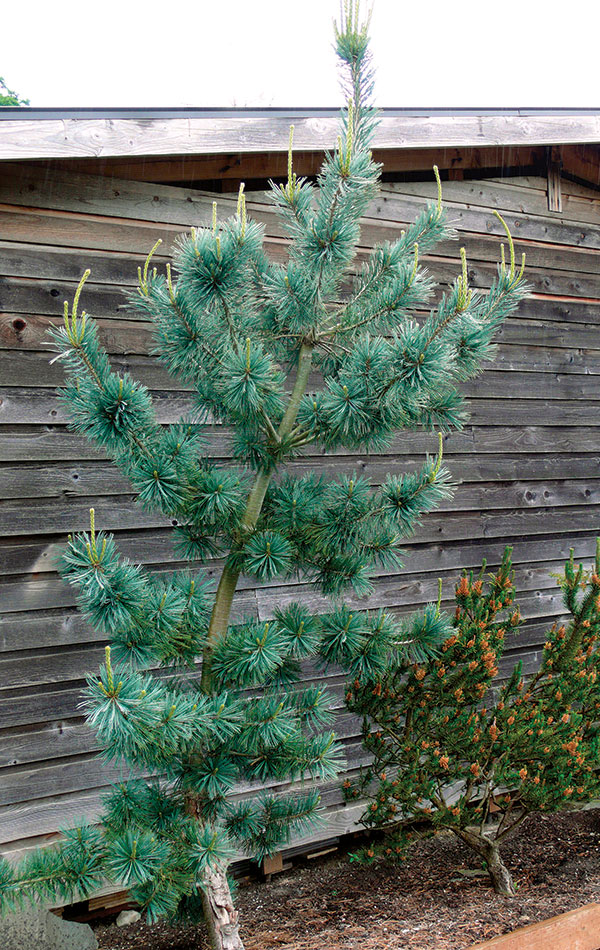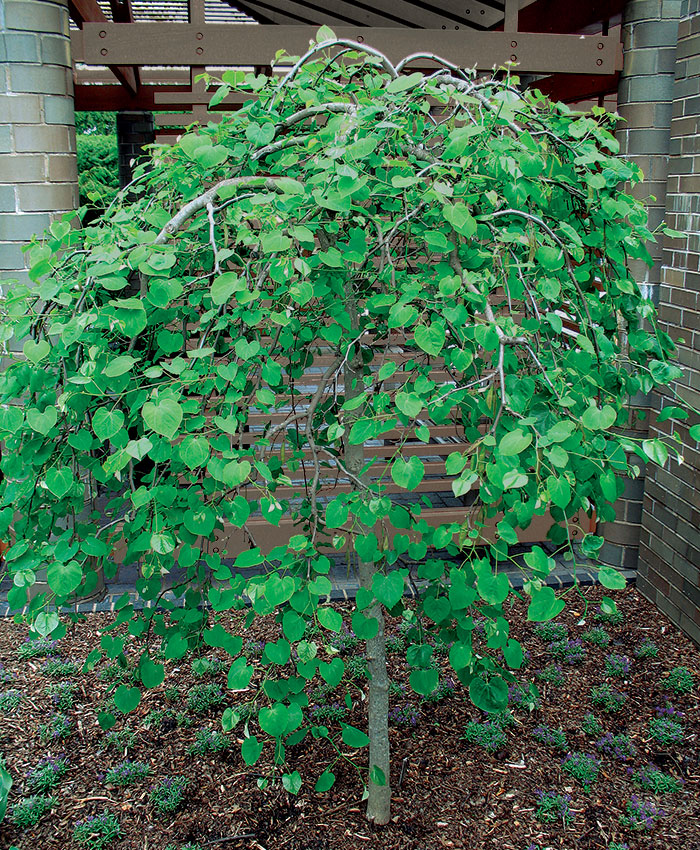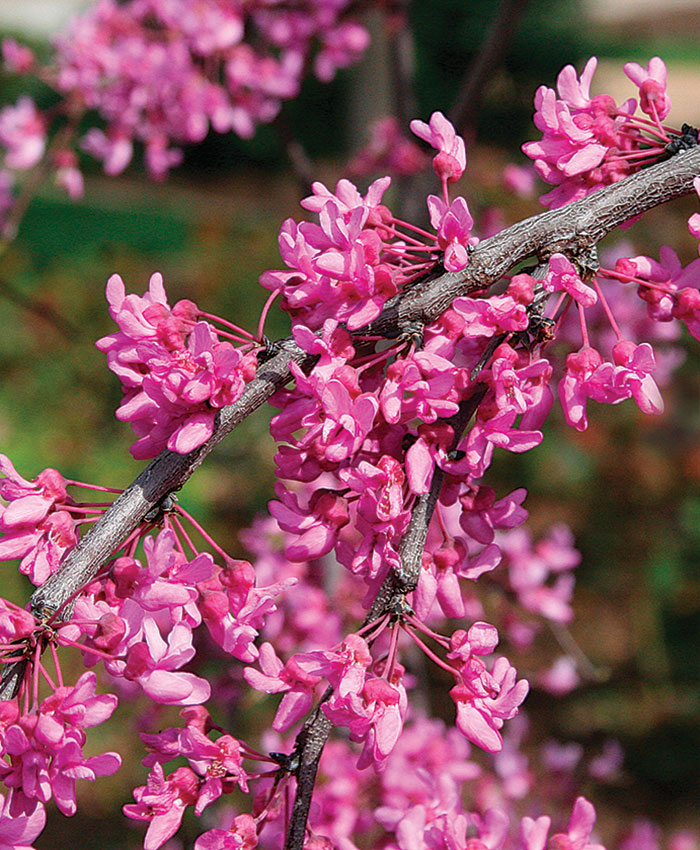Trees for Tight Spaces
Think you don’t have room? Never feel restricted again with these small problem solvers

Most people have an inborn need to connect with nature. But how do we make this connection in a world where houses are getting bigger and yards are getting smaller? Part of the answer, at least, is by creating gardens in the small allotment of tight spaces outdoors that so many of us have to work with. Even larger properties have small nooks, which seem like impossible spots to plant. But a narrow side yard, a lifeless courtyard, or an uninviting roof deck are all golden opportunities for a petite green space.
Small-space gardeners often encounter three basic problems: The space is jumbled and chaotic, there’s no room for variety, and the space doesn’t connect to the rest of the landscape. And as some of us have learned from dismal experience, it is better to address as many of these issues early in the game rather than late in the design process.
Small, slow-growing trees—those having all the attributes of larger ones but remaining in scale with an undersize environment—can form the backbone of small garden spaces. By carefully selecting the correct trees, a dull, wasted space can be transformed into a refuge. Luckily, today’s gardeners have a wide array of slow-growing dwarf and semi-dwarf trees that require little or no maintenance yet provide year-round interest with unusual color, shape, texture, bark, flowers, fruit, or cones.
Organize a small space with tall, airy trees
When we enter a space, particularly a small or intimate space, we tend to look first horizontally, then vertically. Instinctively, we check—if only for an instant—to make sure we aren’t going to trip or misstep on something. This means it is important to keep a small space organized and not let things get too jumbled on the ground or across the field of vision.
One solution is to plant trees with an open habit: those that allow the viewer to see them and see through them at the same time. Open, airy trees act like transparent curtains, adding structure that can organize a small space into rooms or areas of interest and helping us navigate through the space.
A contorted, upright tree like ‘Diana’ weeping larch is strong enough visually to work as an accent and bold enough to separate a space, yet remains open to what lies beyond it. ‘Diana’ will eventually reach a height well above eye level, and although it has foliage down to the ground, it won’t act as a solid wall, blocking off the rest of the garden. This deciduous conifer has year-round interest, with pendulous, needled branches draping gracefully in summer; turning bright golden orange in fall before dropping; and exposing a contorted, branching silhouette in winter. It reemerges with soft, tufted, lime green needles in spring.

‘Diana’ weeping larch
Name: Larix kaempferi ‘Diana’
Zones: 5 to 7
Size: 8 to 15 feet tall and wide
Conditions: Full sun; well-drained soil
‘Tamukeyama’ Japanese maple
Name: Acer palmatum var. dissectum ‘Tamukeyama’
Zones: 5 to 8
Size: Up to 7 feet tall and wide
Conditions: Partial shade; moist, well-drained soil
A deciduous tree with similar characteristics is ‘Tamukeyama’ Japanese maple. Through the growing season, ‘Tamukeyama’ maintains a consistent dark purple color better than most red Japanese maples, even in high heat and humidity. In fall, the leaves flame out to a breathtaking bright scarlet. I also like ‘Tamukeyama’ because it takes well to staking, which creates additional interest with a more open, irregular structure. As with most Japanese maples, consistency in watering is more important than volume for optimal health.
Everyone wants a national arboretum in their courtyard, but adding variety and texture without overcrowding is always an issue in a small space, particularly at ground level. As a solution, consider trees that add space—visual space—to your limited area with narrow, upright habits. Trees that grow above eye level take up only a little precious yard space by, instead, claiming a certain amount of the overhead sky and helping alleviate the cramped feel common to small spaces.

‘Twisted Growth’ deodar cedar
Name: Cedrus deodara ‘Twisted Growth’
Zones: 6 to 9
Size: 8 to 15 feet tall and 3 to 4 feet wide
Conditions: Full sun; well-drained soil
Some trees ideally suited for this situation are ‘Twisted Growth’ deodar cedar and ‘Hillside Upright’ spruce. The deodar cedar has distinctive slender silver-green needles. Its branches casually droop, carving arches in the skyline. This elegant tree is drought tolerant once established in well-drained soils.
‘Hillside Upright’ spruce
Name: Picea abies ‘Hillside Upright’
Zones: 3 to 8
Size: 10 to 12 feet tall and 6 to 8 feet wide
Conditions: Full sun; moist, well-drained soil
The sturdy, open, lush foliage of ‘Hillside Upright’ spruce makes it a good backdrop for a smaller garden. This tree has truly unique, irregular branching. These trees, with their narrow, twisting branches, pull the eye up, expanding the sense of space.

‘Cesarini Blue’ limber pine
Name: Pinus flexilis ‘Cesarini Blue’
Zones: 3 to 7
Size: 10 to 12 feet tall and 5 to 7 feet wide
Conditions: Full sun; well-drained soil
For a denser upright tree that provides a bit of narrow screening, a good choice is ‘Cesarini Blue’ limber pine. If left unstaked, this tree forms a lyrical, curving leader. Alternatively, it can be kept much smaller and denser with annual pruning. ‘Cesarini Blue’ is reasonably drought tolerant once established in well-drained soils and provides an ideal focal point with its long, strikingly blue needles.
For a deciduous selection, a narrow tree like ‘Cumulus’ Alleghany serviceberry will successfully add variety to your space-conscious landscape. ‘Cumulus’ is an open upright tree, taller than it is wide, producing showy white flowers in spring, purple edible fruit in midsummer, and dramatic orange-red leaves in fall.
‘Cumulus’ Alleghany serviceberry
Name: Amelanchier laevis ‘Cumulus’
Zones: 5 to 9
Size: 15 to 25 feet tall and 10 to 15 feet wide
Conditions: Full sun to partial shade; moist, well-drained, acidic soil
Tie the landscape together with short, squat trees
Another problem commonly encountered when designing small spots is finding a way to provide low, space-conscious structure with trees that carry the bulk of their mass below eye level. These trees are often important in tying together the landscape and connecting it to water features, garden art, and hardscaping. Their low visual center of gravity—typically from squat or weeping shapes—makes this possible. An additional advantage to these smaller trees is that they often are the easiest and best varieties for growing in containers. Their smaller stature aboveground translates to smaller root requirements below ground.
‘Green Prince’ cedar
Name: Cedrus libani ‘Green Prince’
Zones: 6 to 9
Size: 3 to 5 feet tall and wide
Conditions: Full sun to partial shade; well-drained soil
One of my favorites for this tight situation is ‘Green Prince’ cedar. A natural bonsai, this quirky little tree takes many forms. With short, medium green needles and dramatic, irregular branching, some specimens grow up and others grow out, but all look attractive. ‘Green Prince’ cedar is a low-maintenance, high-impact small tree wherever you plant it.

‘Viridis’ Japanese maple
Name: Acer palmatum var. dissectum ‘Viridis’
Zones: 5 to 8
Size: 4 to 6 feet tall and 8 to 10 feet wide
Conditions: Full sun to partial shade; moist, well-drained soil
Trees with a strong weeping nature anchor small gardens. A good example is ‘Viridis’ Japanese maple. The name ‘Viridis’ is used for many green laceleaf maples but always refers to a tree with narrow, deeply cut, bright green foliage. The branching is arching, pendulous, and dense, forming a low, compact, rounded dome. These trees can be as much as 8 to 12 feet tall and wide but are more commonly found in the 3-to-4-foot range. ‘Viridis’ can grow in full sun (if not too hot) and turns a beautiful golden hue in fall.
|
|
|
Lavender Twist® redbud
Name: Cercis canadensis ‘Covey’
Zones: 5 to 9
Size: 8 to 10 feet tall and wide, if staked or grafted into a standard
Conditions: Full sun to partial shade; moist, well-drained soil
Another weeping beauty is Lavender Twist® redbud. The branching structure of this tree starts off horizontally and then cascades in a tight, overlapping pattern right down to the ground (creating an ideal tent or fort for imaginative youngsters). Pinkish purple flowers cover the branches in early spring before the emergence of heart-shaped green leaves. Fall color is yellow to golden bronze. Lavender Twist® also has a contorted branch structure, which gives it some winter interest.
With the right small trees as a foundation, even the most disorganized and unimaginative, cramped space can be transformed into a unique garden sanctuary.
The downside of placing big trees in small spaces
Take a drive around your neighborhood and you’ll inevitably see plants that are overstepping their boundaries: a large tree shoved against a foundation, a huge shrub growing into the adjoining yard. Aside from being unsightly, these scenarios can also cause a negative environmental impact. Here’s why.
They need more water
Large trees in a small space have overly compacted roots, so they require a tremendous amount of excess water.
They get sick
Forcing a plant into an unnaturally confined space causes stress, which encourages disease and leads some gardeners to use chemicals to solve the situation.
They need to be cut back often
Eventually, a big tree will outgrow its spot and, despite regular pruning, will need to be cut down—making you and the tree unhappy.
David Leckey is the owner of Oregon Small Trees Nursery in Wilsonville, Oregon.
Photos, except where noted: Ancil Nance
Sources
- Arrowhead Alpines, Fowlerville, Mich.; 517-223-3581; arrowheadalpines.com
- Forestfarm, Williams, Ore.; 541-846-7269; forestfarm.com












Comments
Log in or create an account to post a comment.
Sign up Log in